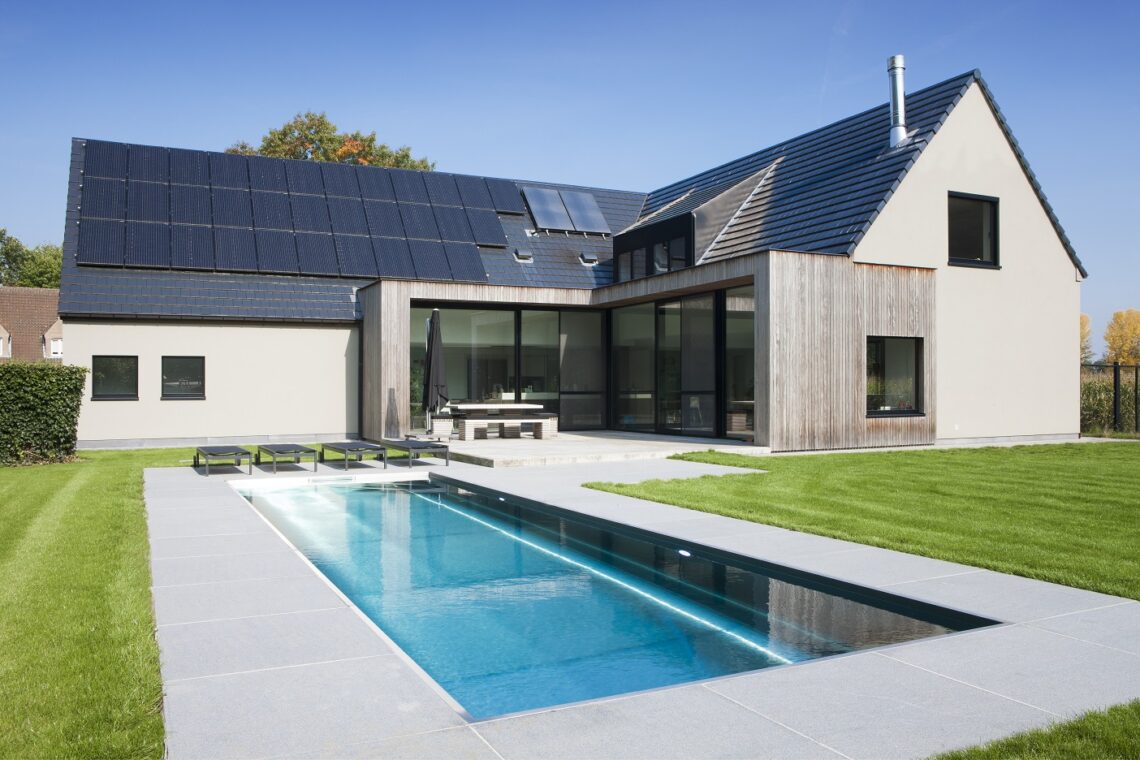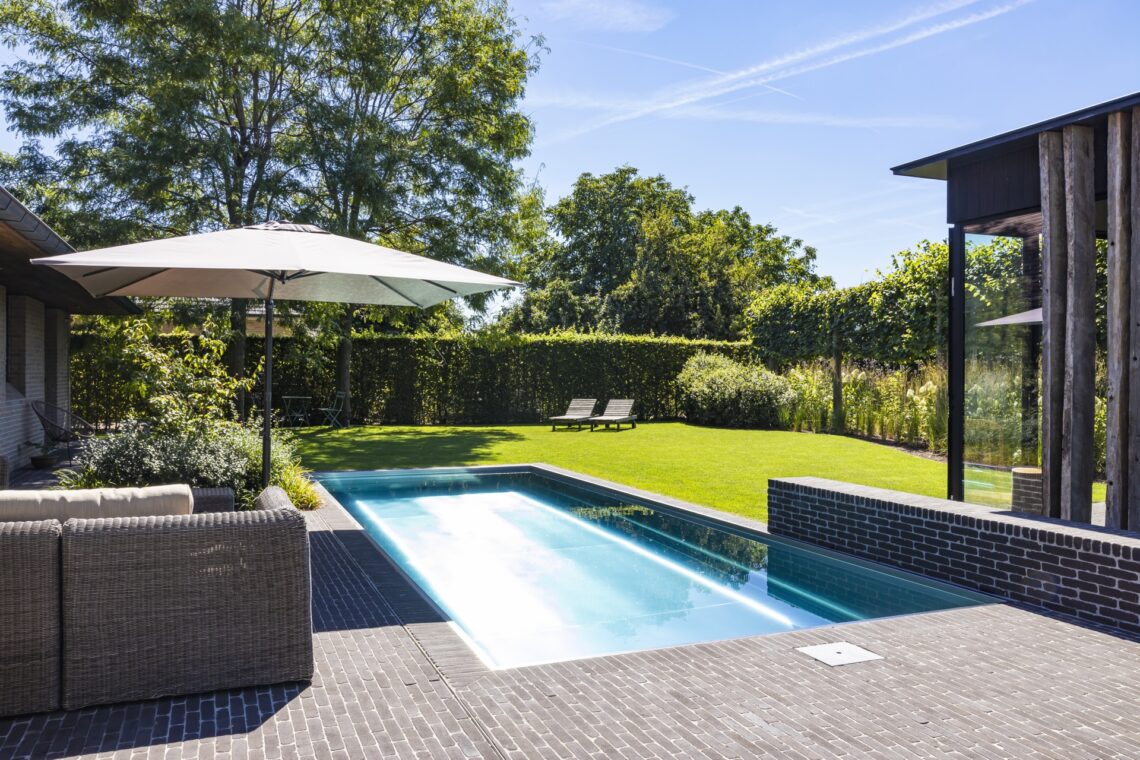How do I reduce my pool’s energy consumption?

The blog below was written by Philippe D’hont of Nouv’eau Swimming Pools.
Analog and digital counter
Until 2025, if you still have an analog counter, you can still use this. However, if you wish to install solar panels, you will need to switch to a digital counter.
The analog counter (reversing counter) is only interesting when your PV system more or less matches your consumption. In other words, if you don’t have a PV system yet, it is undersized or your consumption is increasing; then it is very wise to install solar panels (additionally). Consequently, you switch to the digital counter, which happens anyway in 2025.
Situations where your consumption increases are e.g.: the purchase of an electric car (2000 kWh per 10000km) or a swimming pool (3000 to 4000 kWh).
My further argument assumes a family with a digital counter.
Self-consumption: what is it and what is its importance?
Today, you have a PV system sized for your current consumption.
Self-consumption will be about 30% of what the solar panels generate.
The rest is injected into the grid at about 20 euro cents/kWh. 70% of consumption still comes from the grid and thus is paid to the energy supplier minus the injected electricity.
So increasing self-consumption is important to get efficiency from your PV system. So consuming as much as possible during the day when the solar panels yield is the message.
Why correctly size the power output of your PV system to current or future consumption?
An example:
No pool and PV installation matched to current consumption:
Your solar panels yield 4000kWh per year, which amounts to a self-consumption of 1200kWh (30%). So this 1200kWh is free energy.
The remaining 2800kWh is injected into the grid, for which today you pay approx. €0.20 receives or €560.
Is your consumption e.g. 4000kWh – 1200kWh = 2800kWh at approx. €0.5, then you still pay €1400 – €560 = €840 per year to the energy supplier.
Swimming pool and PV system remains unchanged:
You plan to build a swimming pool, the consumption was estimated at 4000kWh. Because the pool system (pump + heat pump) runs during the day, self-consumption is increased from an average of 30% to about 60%.
In our example, this means the following:
2400kWh self-consumption
1600kWh injection > €320
Consumption: 8000kWh – 2400kWh = 5600kWh at approx. €0.5, then you still pay €2800 – €320 = €2480 per year to the energy supplier
So the PV installation of 4000kWh is no longer adequate.
Swimming pool and PV system will be expanded i.f. the new consumption:
So it is very wise to install additional solar panels until a generated power of 8000kWh or more can be obtained.
4800kWh self-consumption
3200kWh injection > €640
Consumption: 8000kWh – 4800kWh = 3200kWh at approx. €0.5, then you still pay €1600 – €640 = €960 per year to the energy supplier.
Swimming pool and no PV installation
8000kWh x €0.5 = €4000 annually.
So a swimming pool will consume extra but by installing solar panels and sizing them correctly, this is reduced to a minimum.

But what if you can’t (additionally) install solar panels?
There are undoubtedly families who cannot (additionally) install solar panels. Then what?
Then energy sharing is the solution! This way you can:
- Enter into an agreement with a neighbor or acquaintance who has a capacity surplus on his PV plant, in which the kWh price is agreed upon together. That way you pay a lot less to the energy supplier.
- Energy sharing with your company: the roof of your company building may offer the possibility of installing solar panels and thus allow you to share energy with your private home for free.
Orientation of your solar panels and how to make smart use of them?
The orientation of the solar panels is also an important factor in smartly planning your energy consumption:
- East or West: flatter yield curve but from morning to evening.
- South: large yield between 10 a.m. and 4 p.m.
- Southwest: mainly in the afternoon to evening yields
- Southeast: mainly in the morning to afternoon yields
Not only the power but thus the orientation is important in a PV installation. Through the program of the inverter, the generated power during the day can be consulted in a graph. Thus, it is strongly recommended to set the pool time control accordingly.
Installing a battery?
Installing a battery is quite expensive and is not of interest to every family. If your consumption increases due to e.g. the construction of a swimming pool and your PV system was correctly sized to the new consumption, it is advisable to do a cost-benefit analysis before purchasing a battery after 1 year.
Beware of the capacity fee!
To let us better spread consumption, the government created the capacity tariff. The capacity tariff is determined by peak consumption measured per quarter hour.
For example, if you have an electric car that is charging AND the pool system is running, you can count on high peak consumption that will penalize you financially. So it is advisable to spread the energy consumption by e.g. a smart charging station with “load-balancing”, this will ensure that the power is adjusted to the current load on your grid to avoid high peak consumption. If you do not have a charging station with load-balancing, you can of course also set the maximum power on your charging station, charging will take a little longer but you will avoid extra costs due to the capacity charge.
Smart controls: limitations
Smart control can reduce energy consumption by controlling e.g. the pool (heat) pump based on meteo and generated energy from the PV system.
However, there are limitations and even disadvantages:
Thus comfort is sometimes forgotten, energy consumption is one thing but comfort is also not insignificant. First of all, you chose a heat pump because you would like to swim in pleasant pool water from April to November.
For example, if the heat pump operates only when conditions are optimal, there is a danger that when you just wish to swim the water is not warm enough. This is because the days before were not optimal conditions for the heat pump to operate according to smart control.
On the other hand, the benefit of using the excess energy from your solar panels to heat the pool is limited. The pool water should also not be too warm, and if you don’t swim for a period of time, it is also of little use. It is then better to turn off the heat pump (you can even do this these days with a remote app).
Conclusion
That we need to be energy conscious in current times is undeniable. This does not mean, however, that we should deny ourselves everything.
Provided you observe the above, a well-insulated pool, an efficient heat pump and solar cover; you can still enjoy a heated pool without significant additional energy costs.
We are happy to help you realize your dream while ensuring a reduced ecological footprint.
View Nouv’eau stainless steel pool projects here
Back to blog



